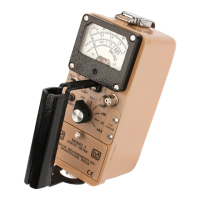
Do you have a question about the LUDLUM MODEL 3 and is the answer not in the manual?
| Detector Compatibility | scintillation detectors |
|---|---|
| Power Source | Two D-cell batteries |
| Display | Analog meter |
| Audio | Built-in speaker |
| Operating Temperature | -20°C to 50°C (-4°F to 122°F) |
| Energy Range | Depends on detector |
| Accuracy | ±10% |
Instructions for unpacking the instrument and checking all included items against the packing list.
Procedure for correctly installing the two 'D' cell batteries into the instrument's compartment.
Steps for connecting a detector to the instrument and performing a battery status check.
Procedure for testing instrument functionality and how to interpret meter face dial readings.
Guidance on performing daily operational checks to ensure instrument and detector functionality.
Details on the instrument's physical dimensions, weight, and construction materials.
Explanation of the meter, connector, range selector switch, calibration controls, and buttons.
Details on the fast/slow toggle switch for adjusting meter response speed and deviation.
Specifies operating temperature, humidity, altitude, and pollution degree for normal use.
Explanation of caution, risk of electric shock, and recycling symbols used on the instrument.
Guidelines for safely cleaning the instrument's exterior and performing minor maintenance.
General procedures for instrument calibration, including exposure rate and CPM methods.
Routine maintenance tasks and guidelines for when recalibration is required.
Instructions for battery removal during storage and handling of potential battery leakage.
Common electronic issues and solutions for the instrument, including cable and meter problems.
Specific troubleshooting steps for Geiger-Mueller (GM) detectors used with the instrument.
Specific troubleshooting steps for scintillator detectors, addressing light leaks and crystal integrity.
Explanation of how the instrument generates and regulates its low and high voltage power supplies.
Description of how detector signals are received and amplified by the instrument's circuitry.
Functionality of the discriminator, audio output generation, and scale ranging mechanisms.
How the meter is driven by pulses and the operation of the meter reset function.
Details on the fast/slow toggle switch that controls the meter's response time.
Part number for the completely assembled Model 3 Survey Meter.
Details and part number for the main circuit board assembly.
List of capacitor components with their reference designators, values, and part numbers.
List of transistors, integrated circuits, diodes, switches, potentiometers, and resistors.
Part numbers for connectors, inductor, and transformer components.
Parts list for audio components, batteries, and various miscellaneous items.
References to drawings for the main circuit board, layout, and chassis wiring.